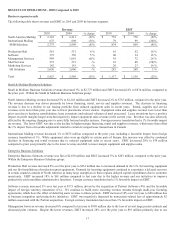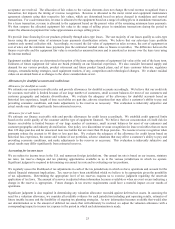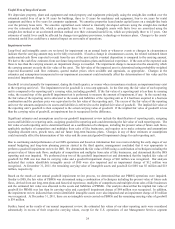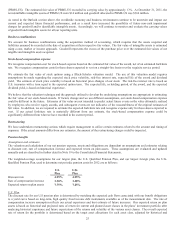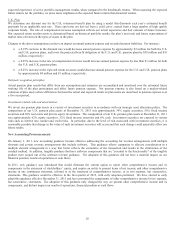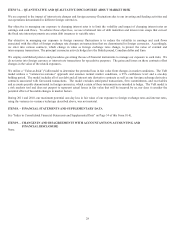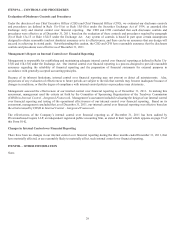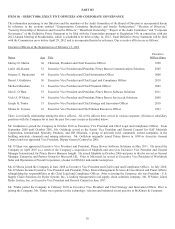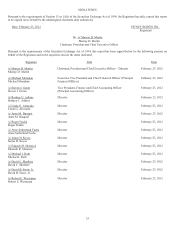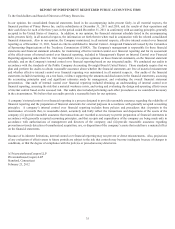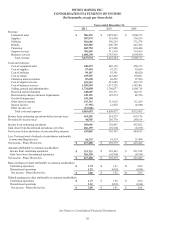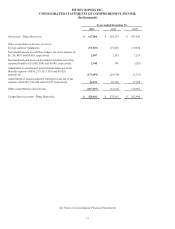Pitney Bowes 2011 Annual Report Download - page 45
Download and view the complete annual report
Please find page 45 of the 2011 Pitney Bowes annual report below. You can navigate through the pages in the report by either clicking on the pages listed below, or by using the keyword search tool below to find specific information within the annual report. 27
Legal and Regulatory Matters
Legal
See Legal Proceedings in Item 3 of this Form 10-K for information regarding our legal proceedings.
Other regulatory matters
As is the case with other large corporations, we are continually under examination by tax authorities in the United States, other
countries and local jurisdictions in which we have operations. The years under examination vary by jurisdiction. Except for a dispute
arising out of a partnership investment, the IRS examination of tax years 2001-2004 is closed to audit and the examination of years
2005-2008 is estimated to be closed to audit within the next 12 months. We have other domestic and international tax filings currently
under examinations or subject to examination. Tax reserves have been established which we believe to be appropriate given the
possibility of tax adjustments. However, the resolution of such matters could have a material impact on our results of operations,
financial position and cash flows. See Note 9 to the Consolidated Financial Statements.
We are currently undergoing unclaimed property audits, which are being conducted by various state authorities. The property subject
to review in this audit process generally includes unclaimed wages, vendor payments and customer receipts. State escheat laws
generally require entities to report and remit abandoned and unclaimed property. Failure to timely report and remit the property can
result in the assessments of additional escheat liability, interest and penalties. It is too early to determine the ultimate outcome of such
audits.
Effects of Inflation and Foreign Exchange
Inflation
Inflation, although minimal in recent years, continues to affect worldwide economies and the way companies operate. It increases
labor costs and operating expenses, and raises costs associated with replacement of fixed assets such as rental equipment. Despite
these growing costs, we have generally been able to maintain profit margins through productivity and efficiency improvements,
introduction of new products and expense reductions.
Foreign Exchange
During 2011, 32% of our revenue was derived from operations outside of the United States. Currency translation increased our 2011
revenue by 2%. Based on the current contribution from our international operations, a 1% increase in the value of the U.S. dollar
would result in a decline in revenue of approximately $17 million.
Changes in the value of the U.S. dollar relative to the currencies of countries in which we operate impact our reported assets,
liabilities, revenue and expenses. Exchange rate fluctuations can also impact the settlement of intercompany receivables and payables
between our subsidiaries in different countries. Our largest foreign currency exposure is to fluctuations in the British pound, Euro
and Canadian dollar, and to a lesser extent, the Australian dollar.
We use foreign exchange contracts to mitigate the risk of foreign currency exchange rate fluctuations. We enter into foreign exchange
contracts with only those financial institutions that meet stringent credit requirements as set forth in our derivative policy to mitigate
our exposure to counterparty credit risk. We regularly review our credit exposure balances as well as the creditworthiness of our
counterparties. Maximum risk of loss on these contracts is limited to the amount of the difference between the spot rate at the date of
the contract delivery and the contracted rate. At December 31, 2011, the fair value of our outstanding foreign exchange contracts was
a net asset of $3 million.
During 2011, deferred translation losses of $54 million were recorded primarily from the strengthening of the U.S. dollar as compared
to the British pound, Euro, Canadian dollar and Australian dollar. In 2010, deferred translation losses of $16 million were recorded
primarily resulting from the strengthening of the U.S. dollar as compared to the British pound and Euro, partially offset by a
weakening of the U.S. dollar as compared to the Canadian dollar. Net deferred translation gains and losses are included in
accumulated other comprehensive loss in stockholders’ deficit in the Consolidated Balance Sheets and do not affect earnings.
Dividends
It is a general practice of our Board of Directors to approve the payment of a cash dividend on our common stock each quarter. In
setting dividend payments, our board considers the dividend rate in relation to our recent and projected earnings and our capital
investment opportunities and requirements. We have paid a dividend each year since 1934.


